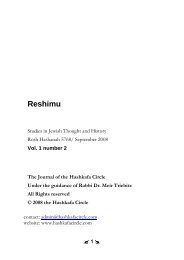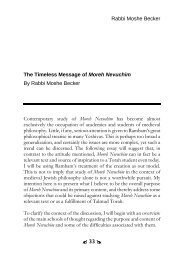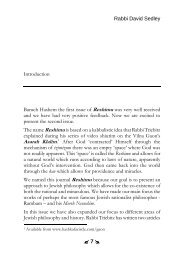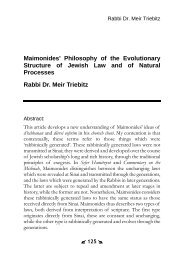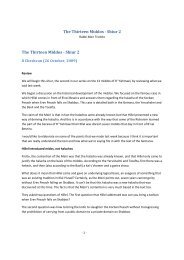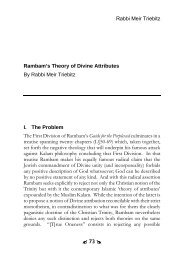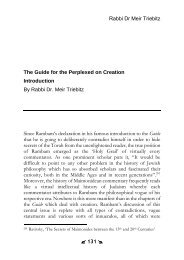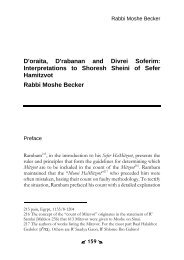Reshimu_3_journal_no.. - Hashkafa Circle
Reshimu_3_journal_no.. - Hashkafa Circle
Reshimu_3_journal_no.. - Hashkafa Circle
You also want an ePaper? Increase the reach of your titles
YUMPU automatically turns print PDFs into web optimized ePapers that Google loves.
Rabbi Moshe Becker<br />
I <strong>no</strong>ted that the Talmud does <strong>no</strong>t testify to its authorship. Halevy<br />
was one of the first to reach the conclusion that although the Talmud<br />
itself may <strong>no</strong>t explicitly claim an author, it is still the most appropriate<br />
place to look for clues to the mystery. With this goal in mind, he set<br />
about a focused scholarly analysis of the text of the Talmud to see<br />
what information could be gleaned. Although many scholars disagree<br />
with Halevy’s conclusions, all admit that his method of searching the<br />
Talmud itself for the key was a significant contribution to the field 7 .<br />
In addition to a rigorous examination of the text of the Talmud and<br />
the clues it may yield, Halevy did make much use of one historical<br />
source, the Iggeret (Epistle of) R’ Sherira Gaon. R’ Sherira Gaon 8 wrote<br />
the Epistle in response to questions posed to him regarding the<br />
transmission of the Oral Law. In his response, R’ Sherira goes into a<br />
detailed chronicle of the generations and individuals responsible for<br />
the transmission of the Torah and Jewish tradition. Naturally, one<br />
would expect such a work to contain a clear statement about the<br />
authorship of the Talmud, yet such a statement is <strong>no</strong>t found in Iggeret<br />
R’ Sherira Gaon. However, several phrases contain references to the<br />
completion of the Talmud, and these feature prominently in Halevy’s<br />
work. The latter clearly considered R’ Sherira Gaon to be<br />
authoritative on the history of the Tradition – seemingly in contrast<br />
with other historians, many of whom questioned the reliability of R’<br />
Sherira’s reports.<br />
addition, see D. Goodblatt’s review in The Formation of the Babylonian Talmud, ed. J.<br />
Neusner, [Leiden: E.J. Brill, 1970] from p. 26.<br />
7 Ibid. p. 25<br />
8 R’ Sherira was the Gaon, or Dean, of the academy in Pumbedita, Babylonia,<br />
during the 10 th century, and one of the most prominent Gaonim.<br />
13



